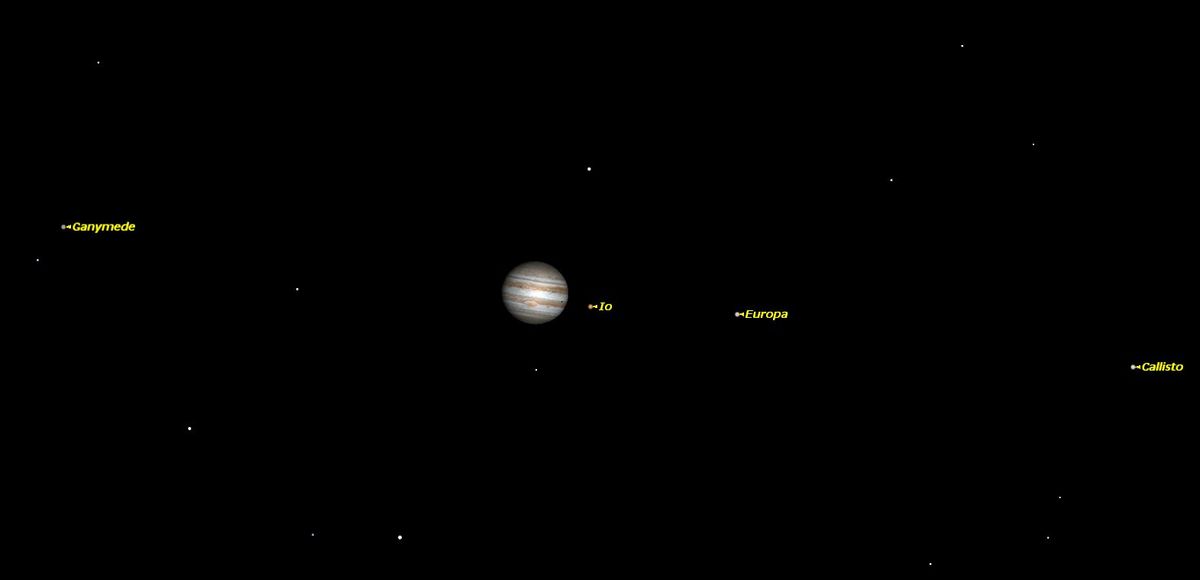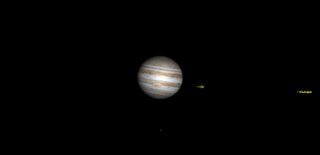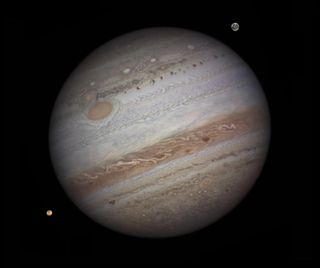Jupiter, King of Planets, Dominates Night Sky This Week

Jupiter is currently the brightest object in the evening sky, visible even in cities with the worst light pollution.
Spotting Jupiter is a treat for all stargazers. For observers in the Northern Hemisphere, it is high overhead as the sky gets dark in the evening, and shines brightly most of the night, setting in the northwest around 3 a.m. EST (0800 GMT).
Currently located in the constellation Gemini, the huge gas giant shares the winter sky with some of the brightest stars. Jupiter is a full magnitude brighter in appearance than the brightest star Sirius. Because it is close to the twin bright stars Castor and Pollux (in the constellation Gemini), it is easy to observe Jupiter's movement against the starry background. The planet is slowly moving closer to Pollux, the southernmost of the two. [See photos of Jupiter, the solar system's largest planet]
How do you tell which is Castor and which is Pollux? Castor, which begins with a "C," is closest to Capella in Auriga, which also begins with a "C." Pollux, which begins with a "P," is closest to Procyon in the constellation Canis Major. Castor (Latin for "beaver," a northern animal) is also closest to the North Celestial Pole. Pollux sounds a lot like "pollex," Latin for "thumb" and is usually lower in the sky than Castor, so think of it as "thumb's down."

Jupiter's moons
If you have binoculars, use them to look at Jupiter. Most of the time, you should be able to see at least one of Jupiter's moons close alongside the bright planet. Even the smallest telescope will show all four of Jupiter's moons clearly.
Jupiter's four brightest moons were among the very first objects to be discovered by Galileo when he turned his telescope on the heavens in 1609. He realized almost immediately that these were moons revolving around a large planet, much as the moon revolves around Earth. This miniature solar system was proof to Galileo that the planets themselves revolved around the sun. It also was the first evidence of objects that stretch beyond the limits imposed by the human eye.
Get the Space.com Newsletter
Breaking space news, the latest updates on rocket launches, skywatching events and more!
Today, these moons are called the Galilean satellites in Galileo's honor. All four are bright enough that they would be visible to the naked eye, if not for the fact that Jupiter itself shines so brightly. [See photos of the Galilean moons of Jupiter]
Sometimes when you look at Jupiter with binoculars or a telescope, one or more of the moons may be missing. That is usually because they are either in front of or behind Jupiter itself. Observers with telescopes can actually watch eclipses and transits of Jupiter’s moons.
A Great Red Spot
It is even possible in larger amateur telescopes to observe the shadows the moons cast upon Jupiter’s cloud tops.
In a good telescope, Jupiter's atmosphere itself provides an endless show. Because of Jupiter's rapid rotation (once every 10 hours) Jupiter's clouds are forced into horizontal jet streams, visible in telescopes as alternating light and dark bands. The dark bands are called "belts" and the light bands "zones." Normally at least two belts are visible, but on nights with steady skies, eight or more belts may be seen.
The best-known object in Jupiter's atmosphere is a gigantic storm known as the Great Red Spot. This is an oval cyclone about three times the width of the Earth, which has been tracked in Jupiter’s atmosphere for three centuries, making it the largest and longest lasting storm in the entire solar system. In order to observe the Great Red Spot, you need to know its current longitude.
Because the Great Red Spot is an atmospheric feature, it tends to drift east or west over time. This makes it impossible to predict its future motion, so we must depend on ongoing observations of its longitude by amateur astronomers to know its current longitude. These observations are collected by Hans-Jörg Mettig, an amateur astronomer in Germany, and posted on his website: http://jupos.privat.t-online.de/rGrs.htm.
If you use a planetarium program to predict when the Great Red Spot will be visible, it will probably be wrong. Most planetarium programs provide some way to enter the current longitude of the Great Red Spot. In Starry Night, for example, there is a file in the Sky Data folder in which you must enter the current longitude. Once the current longitude is entered, your program will display the Great Red Spot at the correct longitude.
Because of Jupiter's rapid rotation, the Great Red Spot is only visible for about three hours at a stretch. It is mainly detectable by its characteristic orange-red color, usually close to salmon pink. It gets darker and fades over time, and sometimes is only visible by the gap it leaves in the South Temperate Belt, known as the Red Spot Hollow.
It usually requires a good quality telescope with at least 150mm aperture, combined with steady skies, to spot the Spot, but it is well worth the effort.
This article was provided to Space.com by Simulation Curriculum, the leader in space science curriculum solutions and the makers of Starry Night and SkySafari. Follow Starry Night on Twitter @StarryNightEdu. Follow us @Spacedotcom, Facebook and Google+. Original article on Space.com.

Join our Space Forums to keep talking space on the latest missions, night sky and more! And if you have a news tip, correction or comment, let us know at: community@space.com.

Geoff Gaherty was Space.com's Night Sky columnist and in partnership with Starry Night software and a dedicated amateur astronomer who sought to share the wonders of the night sky with the world. Based in Canada, Geoff studied mathematics and physics at McGill University and earned a Ph.D. in anthropology from the University of Toronto, all while pursuing a passion for the night sky and serving as an astronomy communicator. He credited a partial solar eclipse observed in 1946 (at age 5) and his 1957 sighting of the Comet Arend-Roland as a teenager for sparking his interest in amateur astronomy. In 2008, Geoff won the Chant Medal from the Royal Astronomical Society of Canada, an award given to a Canadian amateur astronomer in recognition of their lifetime achievements. Sadly, Geoff passed away July 7, 2016 due to complications from a kidney transplant, but his legacy continues at Starry Night.



